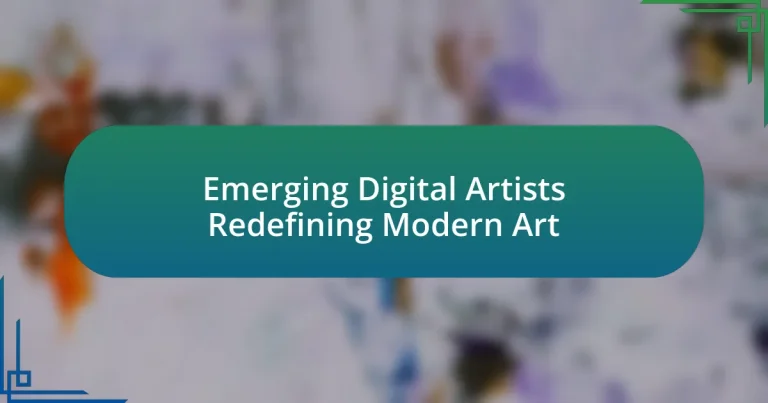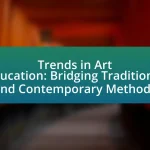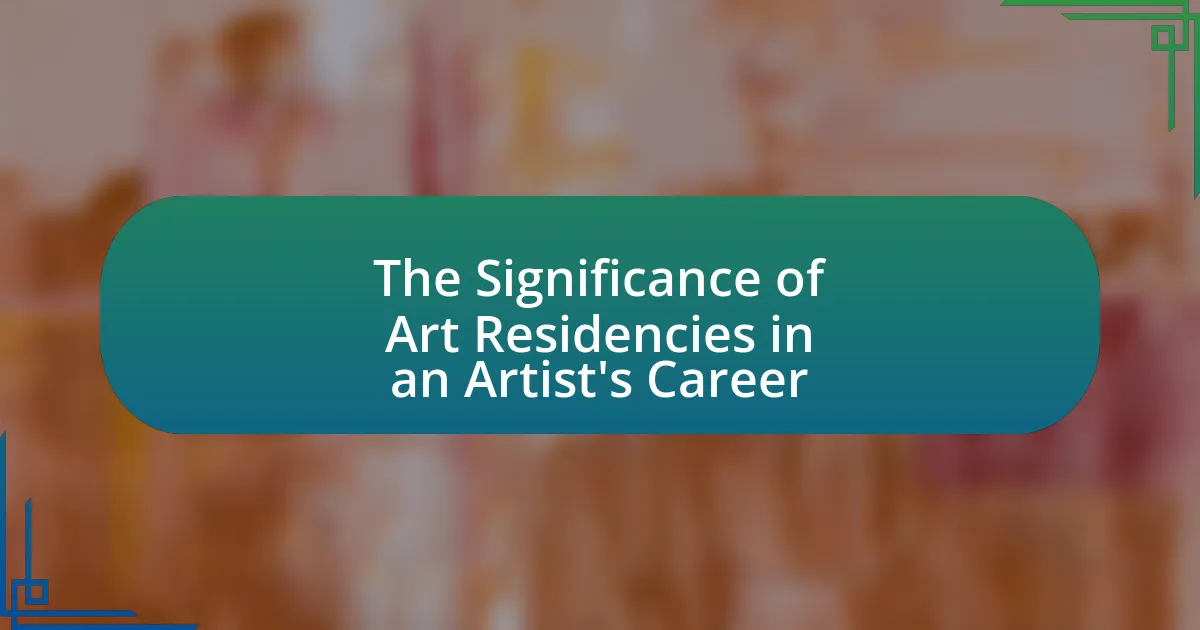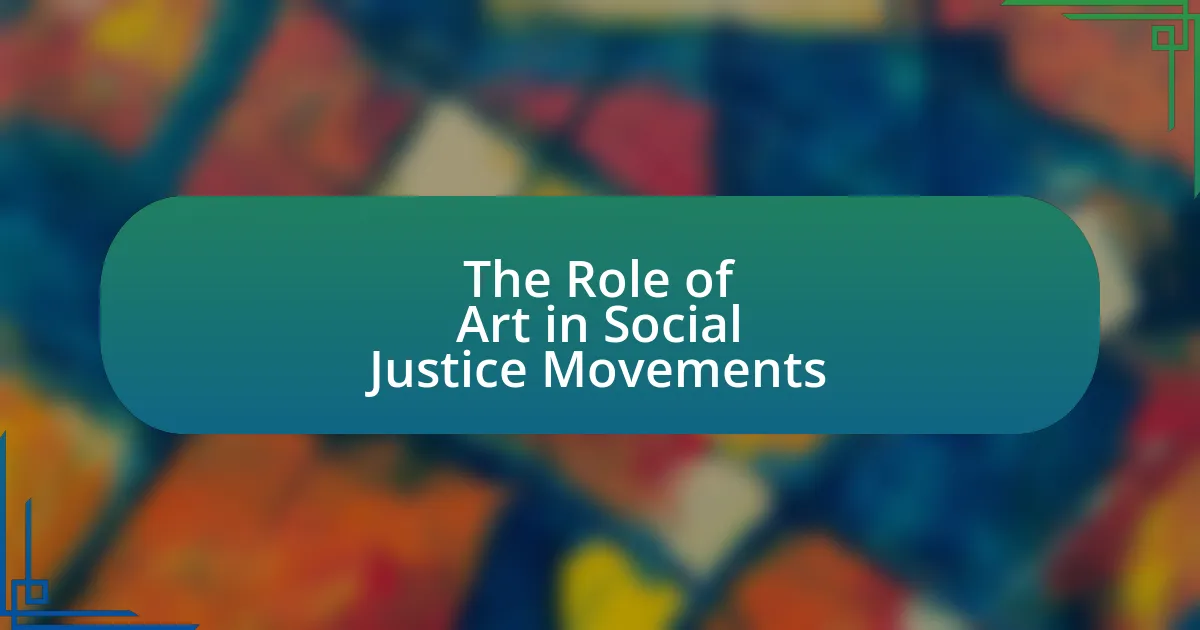Emerging digital artists are creators who primarily use digital technology as their medium, significantly influencing modern art by challenging traditional forms and engaging with contemporary issues. This article explores the distinct characteristics of emerging digital artists compared to traditional artists, the innovative techniques they employ, and the impact of technology on their methods. It also examines the significance of their work in today’s art world, the themes they explore, and the challenges they face, including market saturation and financial constraints. Additionally, the article discusses strategies for enhancing visibility and success, including the role of social media and online galleries in promoting their art.

What are Emerging Digital Artists and Their Role in Modern Art?
Emerging digital artists are creators who utilize digital technology as a primary medium for their artwork, often exploring innovative techniques and concepts that challenge traditional art forms. Their role in modern art is significant as they push the boundaries of creativity, engage with contemporary issues, and utilize platforms like social media and virtual galleries to reach wider audiences. For instance, the rise of NFTs (non-fungible tokens) has allowed these artists to monetize their work in new ways, exemplifying how digital art is reshaping the art market. According to a report by Art Basel and UBS, the global art market for digital art has seen exponential growth, indicating the increasing importance of emerging digital artists in the contemporary art landscape.
How do Emerging Digital Artists differ from traditional artists?
Emerging digital artists differ from traditional artists primarily in their use of technology as a medium for creation. While traditional artists typically utilize physical materials like paint, canvas, and sculpture, emerging digital artists leverage software, digital tools, and online platforms to produce and share their work. This shift allows for innovative techniques such as animation, interactive installations, and virtual reality experiences, which are not possible in traditional art forms. Furthermore, digital artists often engage with global audiences through social media and online galleries, expanding their reach and influence beyond local art scenes. This accessibility and the ability to rapidly iterate on their work highlight a fundamental difference in how emerging digital artists operate compared to their traditional counterparts.
What techniques do Emerging Digital Artists use to create their work?
Emerging digital artists utilize a variety of techniques to create their work, including digital painting, 3D modeling, animation, and augmented reality. Digital painting allows artists to simulate traditional painting techniques using software like Adobe Photoshop or Procreate, enabling them to create intricate and vibrant artworks. 3D modeling involves using software such as Blender or Maya to construct three-dimensional objects, which can be rendered into realistic images or used in virtual environments. Animation techniques, often executed through programs like After Effects or Cinema 4D, enable artists to bring their creations to life through movement. Additionally, augmented reality techniques allow artists to overlay digital elements onto the physical world, often using platforms like ARKit or ARCore, enhancing viewer interaction and engagement. These methods reflect the innovative approaches that define the work of emerging digital artists in the contemporary art scene.
How has technology influenced the methods of Emerging Digital Artists?
Technology has significantly influenced the methods of emerging digital artists by providing advanced tools and platforms for creation, collaboration, and distribution. Digital artists now utilize software like Adobe Creative Suite, Blender, and Procreate, which enable them to create intricate designs and animations that were previously difficult or impossible to achieve. Additionally, the rise of social media and online galleries has transformed how these artists share their work, allowing for instant feedback and wider audience reach. According to a 2021 report by Art Basel and UBS, 70% of artists reported that digital platforms have expanded their visibility and opportunities in the art market. This integration of technology not only enhances artistic expression but also democratizes access to art, enabling a diverse range of voices to emerge in the digital space.
Why is the work of Emerging Digital Artists significant in today’s art world?
The work of Emerging Digital Artists is significant in today’s art world because it challenges traditional artistic boundaries and embraces new technologies. These artists utilize digital tools to create innovative forms of expression, such as virtual reality, augmented reality, and interactive installations, which engage audiences in unique ways. For instance, the rise of NFTs (non-fungible tokens) has transformed how art is bought, sold, and perceived, allowing artists to reach global markets directly and retain ownership of their work. This shift not only democratizes the art world but also reflects contemporary societal themes, such as identity, technology, and the environment, making their contributions vital to the ongoing evolution of modern art.
What themes are commonly explored by Emerging Digital Artists?
Emerging digital artists commonly explore themes such as identity, technology, and social issues. These artists often reflect on personal and collective identities, examining how digital culture influences self-perception and community dynamics. Additionally, they engage with the impact of technology on society, critiquing its role in communication, privacy, and surveillance. Social issues, including climate change, inequality, and political unrest, are also prevalent, as artists use digital mediums to raise awareness and provoke dialogue. This thematic exploration is supported by the increasing integration of digital art in contemporary discourse, highlighting its relevance in addressing modern challenges.
How do Emerging Digital Artists challenge conventional art norms?
Emerging digital artists challenge conventional art norms by utilizing technology to create interactive and immersive experiences that traditional mediums cannot offer. They often employ digital tools such as software for animation, 3D modeling, and virtual reality, which allows for innovative forms of expression that defy the static nature of traditional art. For instance, artists like Refik Anadol use data-driven algorithms to create dynamic installations that change in real-time, pushing the boundaries of what art can be. This shift not only redefines the artist’s role but also transforms the audience’s engagement, making art more accessible and participatory.
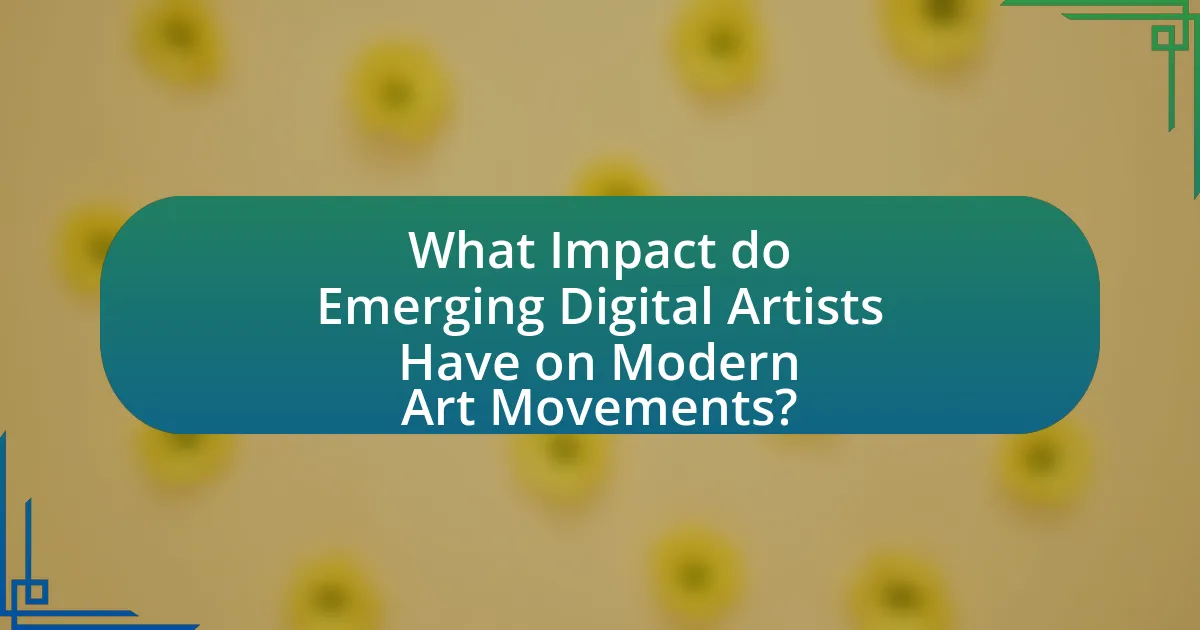
What Impact do Emerging Digital Artists Have on Modern Art Movements?
Emerging digital artists significantly influence modern art movements by introducing innovative techniques and concepts that challenge traditional artistic boundaries. Their use of technology, such as virtual reality, augmented reality, and digital installations, expands the definition of art and engages audiences in interactive experiences. For instance, the rise of NFTs (non-fungible tokens) has transformed how art is bought, sold, and perceived, creating new economic models and democratizing access to art. This shift is evident in the success of platforms like SuperRare and Foundation, where digital artworks have sold for millions, indicating a growing acceptance and valuation of digital art within the broader art market. Additionally, emerging digital artists often address contemporary social issues through their work, reflecting and shaping cultural dialogues, which further solidifies their impact on modern art movements.
How are Emerging Digital Artists shaping contemporary art trends?
Emerging digital artists are significantly shaping contemporary art trends by integrating technology and interactive elements into their work. This integration allows for new forms of expression, such as virtual reality, augmented reality, and generative art, which challenge traditional artistic boundaries. For instance, artists like Refik Anadol utilize data-driven algorithms to create immersive installations that engage viewers in novel ways, reflecting the increasing intersection of art and technology. Furthermore, platforms like Instagram and online galleries have democratized art distribution, enabling these artists to reach global audiences and influence trends rapidly. This shift is evidenced by the rise of NFT art, which has transformed how art is bought, sold, and valued, indicating a fundamental change in the art market driven by emerging digital creators.
What movements are influenced by the work of Emerging Digital Artists?
Emerging Digital Artists influence several movements, including contemporary art, new media art, and digital activism. Their work often incorporates technology and interactive elements, pushing the boundaries of traditional art forms. For instance, contemporary art has evolved to embrace digital mediums, as seen in exhibitions that feature virtual reality and augmented reality installations. New media art specifically focuses on the use of digital technologies as a primary medium, reflecting the impact of the internet and social media on artistic expression. Additionally, digital activism utilizes art to address social and political issues, demonstrating how emerging digital artists engage with current events and societal challenges through their innovative practices.
How do Emerging Digital Artists contribute to the dialogue around art and society?
Emerging digital artists contribute to the dialogue around art and society by utilizing technology to explore contemporary issues, challenge traditional art forms, and engage diverse audiences. They create interactive and immersive experiences that reflect societal changes, such as social justice, identity, and environmental concerns. For instance, projects like “The Invisible Man” by artist and technologist Refik Anadol use data visualization to address themes of surveillance and privacy, prompting discussions about the implications of technology in daily life. Additionally, platforms like Instagram and online galleries allow these artists to reach global audiences, democratizing access to art and fostering community engagement. This shift not only redefines artistic expression but also encourages critical conversations about the role of art in shaping societal narratives.
What challenges do Emerging Digital Artists face in the art industry?
Emerging digital artists face significant challenges in the art industry, primarily including market saturation, lack of recognition, and issues with copyright and ownership. Market saturation occurs as the digital art space becomes increasingly crowded, making it difficult for new artists to stand out. According to a 2021 report by Art Basel and UBS, the number of digital artists has surged, leading to heightened competition. Lack of recognition is another challenge, as traditional art institutions often overlook digital art, limiting opportunities for exposure and validation. Furthermore, copyright and ownership issues arise due to the ease of reproducing digital works, complicating the protection of artists’ intellectual property. A study by the World Intellectual Property Organization in 2020 highlighted that many digital artists struggle to navigate these legal complexities, impacting their ability to monetize their work effectively.
How do financial constraints affect the work of Emerging Digital Artists?
Financial constraints significantly limit the creative output and opportunities for emerging digital artists. These artists often struggle to access essential tools, software, and platforms necessary for their work, which can hinder their ability to produce high-quality art. For instance, a survey by the Creative Industries Federation in 2020 indicated that 62% of artists reported financial barriers as a major obstacle to their practice. Additionally, limited funding can restrict their ability to participate in exhibitions or collaborations, further isolating them from potential audiences and networks. Consequently, financial constraints not only impact the quality and quantity of their work but also their visibility and career growth in the competitive art market.
What barriers exist for Emerging Digital Artists in gaining recognition?
Emerging digital artists face several barriers in gaining recognition, including market saturation, lack of access to traditional art institutions, and limited visibility on digital platforms. The digital art space is crowded, with numerous creators competing for attention, making it challenging for new artists to stand out. Additionally, many traditional galleries and art institutions often overlook digital art, which can hinder opportunities for exhibitions and sales. Furthermore, algorithms on social media and art-sharing platforms can limit the exposure of emerging artists, as their work may not reach a broader audience without strategic marketing efforts. These factors collectively contribute to the difficulties faced by emerging digital artists in achieving recognition in the art world.

How Can Emerging Digital Artists Enhance Their Visibility and Success?
Emerging digital artists can enhance their visibility and success by leveraging social media platforms, participating in online art communities, and showcasing their work through digital galleries. Social media platforms like Instagram and TikTok allow artists to reach a global audience, with Instagram reporting over 1 billion monthly active users, making it a vital space for visual artists. Engaging with online art communities, such as DeviantArt or Behance, provides networking opportunities and feedback, which can lead to collaborations and increased exposure. Additionally, digital galleries and virtual exhibitions have gained popularity, especially post-pandemic, allowing artists to present their work to a wider audience without geographical limitations. These strategies collectively contribute to building a personal brand and increasing marketability in the competitive art landscape.
What strategies can Emerging Digital Artists use to promote their work?
Emerging digital artists can promote their work through social media platforms, online galleries, and collaborations. Utilizing platforms like Instagram and TikTok allows artists to showcase their creations to a broad audience, as these platforms have millions of active users and are visually oriented. Online galleries, such as Saatchi Art and ArtStation, provide artists with a dedicated space to display their portfolios and connect with potential buyers. Collaborating with other artists or influencers can also expand reach and introduce their work to new audiences, leveraging the existing follower base of their partners. These strategies are effective because they tap into established networks and platforms that prioritize visual content, making it easier for artists to gain visibility and engage with their target audience.
How can social media platforms benefit Emerging Digital Artists?
Social media platforms can significantly benefit emerging digital artists by providing them with a global audience and opportunities for exposure. These platforms enable artists to showcase their work to millions of users, facilitating connections with potential buyers, collaborators, and art communities. For instance, Instagram reports that 80% of users follow at least one business account, indicating a strong interest in discovering new artists and art forms. Additionally, platforms like TikTok and Twitter allow artists to engage with their audience through creative content, enhancing their visibility and brand recognition. This accessibility can lead to increased sales, commissions, and networking opportunities, ultimately fostering the growth of their careers in the digital art space.
What role do online galleries and exhibitions play in showcasing their art?
Online galleries and exhibitions play a crucial role in showcasing art by providing a platform for artists to reach a global audience without the constraints of physical space. These digital venues enable artists to display their work to diverse viewers, facilitating greater accessibility and engagement. For instance, a study by the National Endowment for the Arts found that online exhibitions can increase audience reach by up to 300%, allowing emerging digital artists to gain visibility and recognition that traditional galleries may not offer. Additionally, online platforms often incorporate interactive features, such as virtual tours and artist interviews, enhancing the viewer’s experience and connection to the artwork.
What resources are available for Emerging Digital Artists to develop their skills?
Emerging digital artists can develop their skills through various resources, including online courses, workshops, and community platforms. Online platforms like Skillshare and Coursera offer structured courses on digital art techniques, software usage, and creative processes, enabling artists to learn at their own pace. Workshops hosted by organizations such as Adobe and local art schools provide hands-on experience and mentorship from industry professionals. Additionally, community platforms like DeviantArt and ArtStation allow artists to share their work, receive feedback, and connect with peers, fostering a collaborative learning environment. These resources collectively enhance the skill set of emerging digital artists, equipping them with the necessary tools to succeed in the evolving art landscape.
Which online courses or workshops are recommended for Emerging Digital Artists?
Recommended online courses for emerging digital artists include “Digital Painting in Photoshop” on Udemy, which teaches essential techniques for creating digital art, and “Introduction to Digital Art” on Coursera, offered by California Institute of the Arts, focusing on foundational skills in digital media. Additionally, “The Complete Guide to Digital Art” on Skillshare provides comprehensive insights into various digital art forms. These courses are recognized for their structured content and practical assignments, making them suitable for artists looking to enhance their skills in the digital realm.
How can networking with other artists enhance opportunities for Emerging Digital Artists?
Networking with other artists enhances opportunities for Emerging Digital Artists by facilitating collaboration, exposure, and access to resources. When these artists connect with peers, they can share techniques, ideas, and feedback, which can lead to innovative projects and improved skills. Additionally, networking often opens doors to exhibitions, workshops, and online platforms where their work can be showcased to a broader audience. For instance, a study by the National Endowment for the Arts found that artists who engage in collaborative practices are more likely to gain visibility and recognition in their fields. This increased visibility can lead to sales, commissions, and partnerships that are crucial for career advancement.
What are the best practices for Emerging Digital Artists to thrive in the modern art scene?
Emerging digital artists can thrive in the modern art scene by actively engaging with online platforms, building a strong personal brand, and networking within the art community. Utilizing social media platforms like Instagram and TikTok allows artists to showcase their work to a global audience, increasing visibility and potential sales. Establishing a cohesive personal brand helps in creating a recognizable identity, which is crucial in a crowded market. Networking through online forums, art fairs, and collaborations fosters connections that can lead to opportunities for exhibitions and sales. According to a 2021 report by Art Basel and UBS, 57% of collectors purchased art online, highlighting the importance of digital presence for artists.
